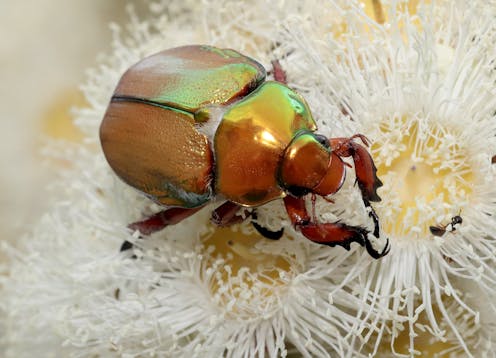People worry Christmas beetles are disappearing. We're gathering citizen data to see the full picture
- Written by Tanya Latty, Associate professor, University of Sydney

In eastern Australia, the arrival of the summer holidays has traditionally been heralded by big iridescent beetles known as Christmas beetles due to their appearance during the Christmas season.
In recent years, public perception seems to suggest these lovely insects may no longer be arriving in high numbers.
Each year insect scientists like us field questions from the press and public about Christmas beetle populations: where have they gone? Why have their populations shrunk? Is it climate change?
So have Christmas beetles really declined? With the help of people around Australia, we’re working to figure this out.
What are Christmas beetles?
In most of Australia, the term “Christmas beetle” refers to large beetles in the genus Anoplognathus. There are 36 Christmas beetle species, almost all of which are only found in Australia.
Christmas beetles are most common along the east coast and are found over most of the continent, except for a curious absence in the south west.
They emerge in early summer and seek out mates, sometimes pausing to munch on eucalyptus leaves. Females lay their eggs in the soil. After a few weeks, these eggs hatch into chunky white or cream coloured larvae often known as “curl grubs”.
Larvae live in the soil for 1–2 years until forming a pupa and transforming into their final adult form. They then dig their way out of the ground and take to the air, starting the cycle again.
Commonly observed species like the washerwoman (Anoplognathus porosus) and A. olivieri have classic Christmas beetle colouring, with flecks of iridescence across their tawny brown bodies.
But not all Christmas beetles are iridescent. Some, like the Granny Smith beetle (A. prasinus), are a vibrant green, while others look golden (A. aureus and A. parvulus).
To make things more complicated, people in Tasmania tend to use the term “Christmas beetle” to refer to the glorious golden stag beetle (Lamprima aurata). A lovely beetle to be sure – but not the kind we’re talking about.
Christmas beetles are also frequently confused with other scarab beetles, especially Argentinian lawn scarabs (Cyclocephala signaticollis) which are very common in the summer, particularly in cities. Argentinian lawn scarabs are smaller than most Christmas beetles and lack the distinct thickened back legs and scoop-shaped snout.
Native flower chafers such as fiddler beetles (Eupoecila australasiae), punctate flower chafers (Neorrhina punctata) and cowboy beetles (Chondropyga dorsalis) are also commonly mistaken for Christmas beetles. These beautiful summer-active beetles are pollinators of native flowers.
Have Christmas beetles declined?
Unfortunately, we don’t have long term population data for any Christmas beetle species, so we cannot conclusively say if there’s been a decline. However, many people (including some of the authors) remember there being more Christmas beetles in the past.
But memory alone is not strong enough evidence, so we’ve designed a project to help us determine the health of Christmas beetle populations. The Christmas Beetle Count is a community science project led by conservation organisation Invertebrates Australia in collaboration with the University of Sydney.
We are asking the public to submit their sightings of Christmas beetles to the online database iNaturalist. We can then use the data to determine which Christmas beetle species are likely to be at risk of decline or extinction.
So far, the project has been a roaring success. As of December 2023, over 8,000 sightings have been submitted by over 4,000 people across Australia, including photos of four very rare species last sighted decades ago.
For one species (A. vietor), our observers took the first known picture of a living individual – it had previously been known only from a single, dead beetle. This record was 300km away from the only site previously known for this species, suggesting it occupies a larger range than thought.
Sightings like these help us better understand the distribution and population health of Christmas beetles, and anyone can help.
Are Christmas beetles coming back in 2023?
It’s too early to determine if Christmas beetles have made a comeback this year. Between November 1 and December 8 2023, 532 “research grade” sightings of Christmas beetles have been reported, more than double from the same period last year.
Although the rise in reported sightings seems promising, it’s possible this increase is not due to a growing beetle population, but rather because more people are aware of the project and are actively searching for Christmas beetles.
We will need a few more years of data before we can say anything conclusive about Christmas beetle population trends.
Why are Christmas beetles important?
Like many insects, Christmas beetles are likely threatened by habitat loss. We can help by conserving our native bushland – Australia’s pledge to preserve 30% of land is welcome news.
These insects play an important ecological role. Since they emerge at a predictable time of the year when many reptiles, mammals and birds are producing and raising their young, adult Christmas beetles may be an important food source for many animals.
The larvae of Christmas beetles tunnel through the soil helping to aerate it and to recycle organic matter. They likely serve as a protein and fat-rich meal for hungry birds, reptiles and mammals.
Christmas beetles are an iconic part of Australia’s natural heritage, as uniquely Australian as koalas, platypuses and kangaroos.
Read more: Don’t kill the curl grubs in your garden – they could be native beetle babies
Authors: Tanya Latty, Associate professor, University of Sydney



